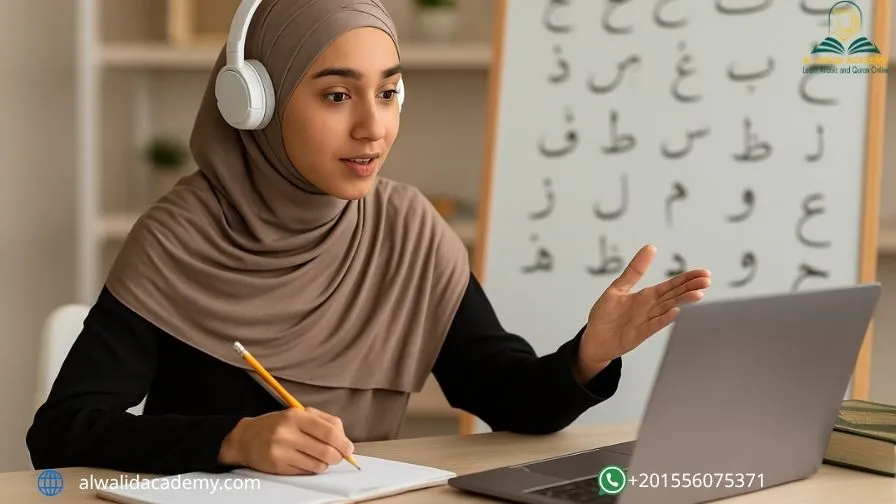Learning how to pronounce Arabic letters with Tajweed is essential for anyone seeking to read the Quran with clarity. Tajweed ensures each letter is articulated from its correct origin, preserving the meaning and beauty of the divine message. Whether you're a beginner or refining your skills, mastering Tajweed transforms your recitation into a spiritually enriching experience rooted in precision and tradition.Tajweed, derived from the Arabic root “جَوَّدَ” (jawwada), meaning “to improve” or “to make better,” is the science of Quranic phonetics.
Learn the Correct Pronunciation of Arabic Letters
Learning the correct pronunciation of Arabic letters is the first step toward mastering Quranic recitation. Each letter in the Arabic alphabet carries a distinct sound, and pronouncing it accurately is essential to preserving the meaning of the words in the Quran. This is where Tajweed comes in a set of rules that guide reciters on how to pronounce Arabic letters with Tajweed, ensuring clarity, precision, and beauty in every verse.
Unlike casual speech, Quranic recitation demands that each letter be articulated from its proper point of origin (makhraj) and with its unique characteristics (sifaat).
By learning Tajweed, students develop a deeper connection with the Quran and gain confidence in their recitation. Whether you're a beginner or revisiting the basics, understanding the correct pronunciation is a vital foundation for your Tajweed journey.
Importance of Correct Letter Pronunciation in Recitation
Reciting the Quran is not just about reading words, it's about conveying divine meaning with precision and reverence. One of the most essential aspects of this is mastering how to pronounce Arabic letters with Tajweed, which ensures that each letter is articulated from its correct point of origin (makhraj) and with its proper characteristics.
Key Reasons Why Correct Pronunciation Matters
-
Preserves the meaning of Quranic verses
Mispronouncing a single letter can alter the meaning, leading to serious misunderstandings.
-
Ensures clarity and precision in recitation
Learning Tajweed helps avoid common mistakes and improves fluency.
-
Reflects respect for the Quran
Speaking the words correctly honors the holiness of the scripture and acknowledges its divine source.
-
Strengthens memory and comprehension
Proper articulation aids in memorization and deeper understanding.
-
Enhances the spiritual experience
A smooth and harmonious recitation helps the heart resonate with the Quran’s message.
-
Fulfills a religious obligation
Observing Tajweed is an obligation for any Muslim who frequently recites the Quran.
Prepared to begin your journey into mastering Tajweed? Try our Tajweed Course now.
Understanding Makharij in Tajweed
Makharij (مخارج الحروف) are the precise locations within the mouth, throat, and nose where Arabic letters originate during pronunciation. Understanding makharij is essential for anyone learning Tajweed, as it ensures each letter is delivered with clarity and precision.
There are five main zones of articulation:
-
Throat (الحلق): for letters like ع, ح, and خ.
-
Tongue (اللسان): the most diverse zone, producing letters like ت, د, and ق.
-
Lips (الشفتان): used for letters such as ب, م, and ف.
-
Nasal cavity (الخيشوم): important for ghunnah (nasal sounds) in letters like ن and م.
-
Oral cavity (الجوف): where elongation (madd) sounds like ا, و, and ي originate.
Without mastering makharij, letters can be confused like س and ص, or د and ض leading to errors in meaning and rhythm. Tajweed rules guide learners to identify and practice these points correctly, often with the help of a qualified teacher.
How to Pronounce Arabic Letters with Tajweed?
Learning how to pronounce Arabic letters with Tajweed is essential for anyone seeking to read the Quran correctly. Tajweed provides a structured system that teaches the proper articulation (makharij) and characteristics (sifaat) of each letter. This ensures that every sound is delivered from its correct origin whether from the throat, tongue, lips, or nasal cavity.
For example, the letter ق is pronounced from the back of the tongue with heaviness (tafkheem), while س is light and whispery. Tajweed also covers rules like ghunnah (nasal sounds) and qalqalah (echoing sounds), which add rhythm and clarity to recitation.
By mastering Tajweed, learners avoid common mistakes that can alter meanings and disrupt the flow of verses. With consistent practice and guidance, Tajweed transforms recitation into a spiritually uplifting experience that honors the divine message of the Quran.
You can unlock the complications of Arabic through our Arabic language Course. Book your seat now.
Read about: How to Understand the Quran Word by Word
How to Pronounce Heavy and Light Arabic Letters
One of the key principles in learning Tajweed is understanding the difference between heavy (tafkheem) and light (tarqeeq) sounds. These characteristics affect the depth and tone of each letter during recitation.
-
Tafkheem (تفخيم) means to pronounce a letter with a full, deep sound. Examples include ص, ض, ط, ظ, غ, and ق.
-
Tarqeeq (ترقيق) refers to a soft, light pronunciation. Letters like س, ت, ك, and ي are pronounced with a thinner sound.
-
Some letters, like ر, can be heavy or light depending on surrounding vowels. For instance, ر is heavy in رَحْمَٰن but light in فِرْقَة.
Looking for a trusted platform to learn the Quran with clarity, depth, and spiritual connection? Al Walid Academy offers a dynamic online learning experience for adults and children alike, combining tradition with modern teaching tools.
Are you longing to recite the Quran with beauty, precision, and reverence? The article How to Learn Quran with Tajweed at Home is your gateway to transforming your recitation into a spiritually enriching experience.

Mastering Difficult Arabic Sounds in Tajweed
Some Arabic letters present unique challenges for learners, especially when trying to master how to pronounce Arabic letters with Tajweed. Letters like ض, ظ, ع, and ق require precise articulation and control, as they originate from deep or complex points in the mouth and throat.
For example
-
ض (Daad) is one of the most difficult letters, pronounced from the side of the tongue with a heavy sound.
-
ع (Ayn) comes from the middle of the throat and demands careful pressure and clarity.
-
ق (Qaaf) is pronounced from the back of the tongue with tafkheem, while ظ (Zhaa) combines heaviness with a slight buzzing quality.
Tajweed provides the tools and techniques to overcome these challenges, guiding learners through makharij and sifaat with structured practice. With patience and repetition, even the most difficult sounds become manageable, allowing for accurate and beautiful Quranic recitation.
Not sure what sets Tajweed apart from Tafseer? You're not alone and this comprehensive guide from our Academy Difference Between Tajweed and Tafseer breaks it down beautifully.
Practicing Ghunnah and Qalqalah Correctly
Ghunnah (Nasal Sound):
This rule applies specifically to the letters ن (Noon) and م (Meem), particularly when they are marked with a shaddah.
-
Produces a soft, humming sound through the nose.
-
Must be held for a specific duration to maintain proper Tajweed flow.
-
Adds smoothness and emotional depth to recitation.
Qalqalah (Echoing Sound):
This rule applies to the letters ق, ط, ب, ج, and د when they are accompanied by a sukoon.
-
Creates a bouncing or echoing effect, especially at the end of words or verses.
-
Enhances clarity and rhythm in pronunciation.
Why It Matters:
-
These are key elements in mastering Tajweed.
-
Proper practice ensures your recitation is both technically precise and spiritually uplifting.
-
Repetition, listening, and guidance from a skilled teacher are essential for improvement.
Need more information? Here is our article about Idgham With Ghunnah and Idgham Without Ghunnah to make it more clear for you.
Step‑by‑Step Guide to Pronouncing Quranic Letters
1. Understand the Makharij (Articulation Points):
-
Learn where each letter originates from the throat, tongue, lips, or nasal passage.
-
This is the foundation of mastering Tajweed.
2. Study the Sifaat (Letter Characteristics):
-
Recognize traits like heaviness (Tafkheem) and softness (Tarqeeq).
-
These affect tone, clarity, and emotional depth in recitation.
3. Practice Letters in Isolation and Words:
-
Start with individual letters, then move to short words.
-
Build fluency gradually through repetition.
4. Use Daily Repetition and Listening:
-
Consistent recitation, paired with attentive listening to expert reciters, helps sharpen your pronunciation and Tajweed skills.
-
Mimic their tone and rhythm for better Tajweed application.
5. Apply Tajweed Rules in Verses:
-
Incorporate Ghunnah, Qalqalah, and other rules while reciting.
-
This brings beauty, precision, and spiritual resonance to your Quranic reading.
Looking to elevate your Quran recitation? Our Quran Recitation Course offers a structured path to mastering Tajweed the science of reciting the Quran with clarity, elegance, and devotion.
Learn about: How to Improve Your Quran Recitation
Common Pronunciation Mistakes and How to Fix Them
When learning how to pronounce Arabic letters with Tajweed, many learners face recurring pronunciation mistakes that can affect the clarity and meaning of Quranic recitation.
Common mistakes to avoid
-
One common error is confusing similar letters, such as س (Seen) and ص (Saad), or د (Dal) and ض (Daad) each has a distinct articulation point and sound.
-
Another frequent issue is neglecting the proper duration of Ghunnah, leading to rushed or unclear nasal sounds. Misapplying Qalqalah the echoing sound in letters like ق, ط, and ب can also disrupt the rhythm of recitation.
-
Misapplying Qalqalah the echoing sound in letters like ق, ط, and ب can also disrupt the rhythm of recitation.
-
A fourth mistake is incorrect elongation (Madd) either shortening or overextending vowels, which can alter the meaning of words and break Tajweed rules.
To fix these mistakes:
-
Practice each letter in isolation using Tajweed charts.
-
Record your recitation and compare it with expert reciters.
-
Use visual aids to identify makharij.
-
Seek feedback from a qualified teacher.
It’s never too late to begin your Quranic journey. Whether you're a beginner or returning to recitation after years, Quran Classes for Adults offer a structured, supportive environment tailored to your pace and goals.
Know more about: Benefits of Becoming a Hafiz
Tips for Clear and Accurate Tajweed Pronunciation
Clear and accurate Tajweed pronunciation is essential for reciting the Quran with beauty and reverence. Whether you're just beginning or refining your skills, understanding Tajweed is the first step toward fluency and confidence. Below are practical tips to help you improve your recitation and deepen your connection with the Quran.
Tips to help you in your journey
-
Learn Tajweed by studying articulation points (makharij) and characteristics (sifaat) of each letter.
-
Recite at a measured pace, focusing on clarity to ensure every sound is accurately shaped and clearly pronounced.
-
Use audio recordings of certified reciters to mimic pronunciation, tone, and rhythm.
-
Record yourself reciting and compare with expert examples to identify areas for improvement.
-
Avoid rushing Tajweed emphasizes precision over speed.
-
Join structured Quran classes where instructors provide realtime correction and personalized feedback.
-
Focus on common Tajweed rules like Ghunnah, Qalqalah, and elongation (madd) to enhance fluency.
-
Make Tajweed practice part of your daily routine, even if it’s just 10 minutes a day.
-
Stay consistent and patient progress comes with regular effort and sincere intention.
Perfect Your Quran Recitation with Al-Walid Academy’s Tajweed Course
Ready to elevate your Quranic recitation? Al-Walid Academy offers one of the most comprehensive online Tajweed programs designed to help you recite the Quran beautifully, accurately, and with deep spiritual connection.
Why Choose Al-Walid’s Tajweed Course?
-
Taught by Certified Tutors with Ijaza from Al-Azhar.
-
Female-Only Classes Available for comfort and cultural sensitivity.
-
Courses for Adults & Children with age-appropriate methods.
-
Flexible Scheduling for busy lifestyles and global learners.
-
Ideal for Non-Arab Speakers seeking authentic Quranic recitation.
-
Graduated Curriculum from beginner to advanced levels.
-
Spiritual Growth Focus connects with the Quran as it was revealed .
Learn Quran, Arabic, and Islamic Studies with certified teachers in fun, interactive, and personalized sessions. Join thousands of students around the world and begin your path today!
Conclusion
Learning the Quran is a lifelong journey one that nurtures the heart, sharpens the mind, and deepens your connection with Allah. Whether you're just beginning or refining your recitation, mastering how to pronounce Arabic letters with Tajweed is a vital step toward reading the Quran with clarity, beauty, and reverence.
With the right guidance, consistent practice, and sincere intention, anyone, child or adult can unlock the treasures of Tajweed and experience the spiritual joy of accurate recitation. Platforms like Al-Walid Academy make this journey accessible, offering expert instruction and flexible learning tailored to your needs.
Start today, and let every letter you recite be a step closer to understanding, devotion, and peace.
FAQ
At what age is it perfect to start Quran lessons for kids?
A: Children as young as 4 can begin. Courses are designed to be age appropriate and engaging.
Is it too late to start learning the Quran as an adult?
A: Not at all. Quran classes for adults are designed to meet you where you are whether you're a beginner or returning after years.
How to pronounce Arabic letters with Tajweed?
A: You’ll learn through guided instruction, focusing on articulation points (Makharij), characteristics (Sifaat), and practical application. Tutors provide real time feedback to help you recite accurately and confidently.
Do I need to know Arabic before joining?
A: No prior knowledge is required. Courses often start with the Arabic alphabet and build gradually.
Are there female instructors available?
A: Absolutely. Our platform offers male and female tutors to ensure comfort and accessibility for all learners.


